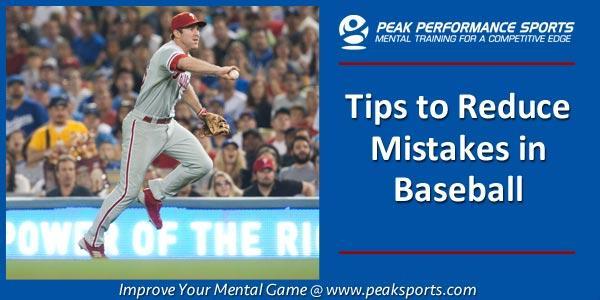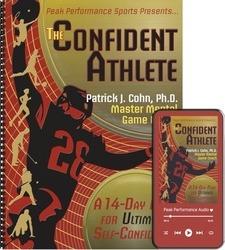
Focus In Critical Moments Of The Game
Have you ever lost your focus during a critical moment in competition and it led to a mistake?
Have you ever wondered exactly what caused that mistake? Was it a physical or mental mistake?
You may attribute mistakes to anxiety. While anxiety can disrupt your focus, there is more to it than just anxiety.
The best way to manage mistakes is to know the process by which they occur…
I interviewed Dr. Tom Hanson in regards to the factors leading to performance errors.
Dr. Tom Hanson is a mental coach and a sport psychology expert.
Hanson wrote the book, “Play Big: Mental Toughness Secrets That Take Baseball Players to the Next Level” and co-authored the popular baseball book, “Heads Up Baseball: Playing the Game One Pitch at a Time.”
In the interview, Hanson discussed his pyramid model for athletic performance.
HANSON: “I have a pyramid divided into five layers; it’s the performance pyramid for me. At the very tip of the top, is performance (what actually happens).
Then the layer just below that is physical, (what did you physically do).
My one example is a guy makes an error at third base… There’s a ground ball that comes to him at third and he lets it go through his legs. So the result is an error [performance]. Next thing, what did you do [physical component]? Well, he pulled his hands up too soon; his muscles got tight and he pulled his hands up.
The third level down is focus. He [third baseman] lost his focus. It wasn’t just on the ball bouncing… Something happened that all of the sudden the ball got blurry or small or mixed in with the background. Somehow it became overwhelming for him.
The next level down is emotions. Why did it [his focus] get disrupted? Well, there was some emotion, most likely fear that gripped him and caused his muscles to contract, including his eyes, which messed up his focus. Then he messed up the physical part and it messed up the result.
What was so scary about this ground ball? Well, then you get to the very bottom [of the pyramid] which is belief. That’s where he’s got a belief that had him perceive that ground ball as a threat.
It’s like oh no, something really bad could happen if I screw this up, and then that kicks in fear, which messes up emotion, which messes up your physical mechanics, which causes the result.”
You can reduce physical mistakes by improving your confidence (belief), managing your game-time emotions, and sharpening your focus. By attacking performance errors at the base level, belief, according to Hanson, you’ll perform better in competition.
Try these tips to reduce mistakes:
- Tip #1: Examine your self-limiting beliefs. Your beliefs can severely undermine your confidence. For example, do you think of yourself as a choker or a slow starter? Objectively debate the validity of your self-limiting beliefs.
- Tip #2: Focus on your goals and not on trying to gain the approval of others (coaches, parents, teammates). When you worry about what others think, you play to not make mistakes (fear of failure).
Listen to and download the full interview with Dr. Tom Hanson and many other top sports psychologists on this page: Peaksports Member Network
Related Sports Psychology Articles
- For Athletes Who Are Highly Critical Post-Game
- How to Stop Being Self-Critical of Your Game
- Athletes Who Are Self-Critical
*Subscribe to The Sports Psychology Podcast on iTunes
*Subscribe to The Sports Psychology Podcast on Spotify
Download a free sports psychology report to improve your mental game!
Learn more about our one-on-one mental game coaching.
The Confident Athlete

“The Confident Athlete” consists of 2 audio programs that include 14 days of confidence fueling exercises and a simple to follow workbook that guides you through the 14 days, helps you apply the strategies, and customizes the exercises to your personal needs.
Let me help you put a stop to the confidence leak. You can learn to have greater levels of confidence in competition than you do in practice by identifying the specific ways you undermine your own confidence and how to convert your practice confidence into COMPETITIVE CONFIDENCE.
“The Confident Athlete” is a ground-breaking system to teach you how to think like a champion and have ultimate self-confidence every time you step on the playing field, court, track, or course. The confident athletes was developed for any athlete – junior to professional –that wants to gain confidence. However, coaches and sports parents can learn how to teach others to perform with ultimate confidence. Use my program if you want to bust a slump or just wanting higher or more consistent levels of self-confidence.

I work with athletic timing. For me, timing is a brain function, which can be measured and can be improved.
I’ve developed a test that measures how well the athlete is able to perform a specific task, which the athlete knows how to do. I measure, in milliseconds, how well-timed the athlete can perform that task. My test results show how many milliseconds ‘off’ the athlete is in 60 test points in a one-minute test (so there is also a rhythm component).
I’ve been doing this testing as part of a timing training program, where people improve their timing and rhythm. In the last 14 years, I have completed more than 10,000 individual tests, while improving the timing and rhythm of many hundreds of individuals.
In recent years I’ve started to understand performance mistakes as a momentary loss of focus and coordination. The graphic results of my tests reveals an athlete’s tendency toward that momentary loss of focus (Artistic ice skaters refer to this momentary loss of focus and coordination as a pop-out). We can chart how many pop-outs an athlete has in a minute and predict the tendency of an athlete to pop-out during the performance of their sport.
From my experience, when we improve the athlete’s timing and rhythm, we reduce the tendency to pop-out and performance mistakes are reduced.
I’m sure that many athletes experience their mistakes in ways which are reflected by Hanson’s model. But, in my experience some of those emotional components are reactions to the confusion of poping-out at a critical moment in the game.
I find it much more productive to simply improve performance and reduce mistakes by improving timing and rhythm, which reduced those pop-outs.